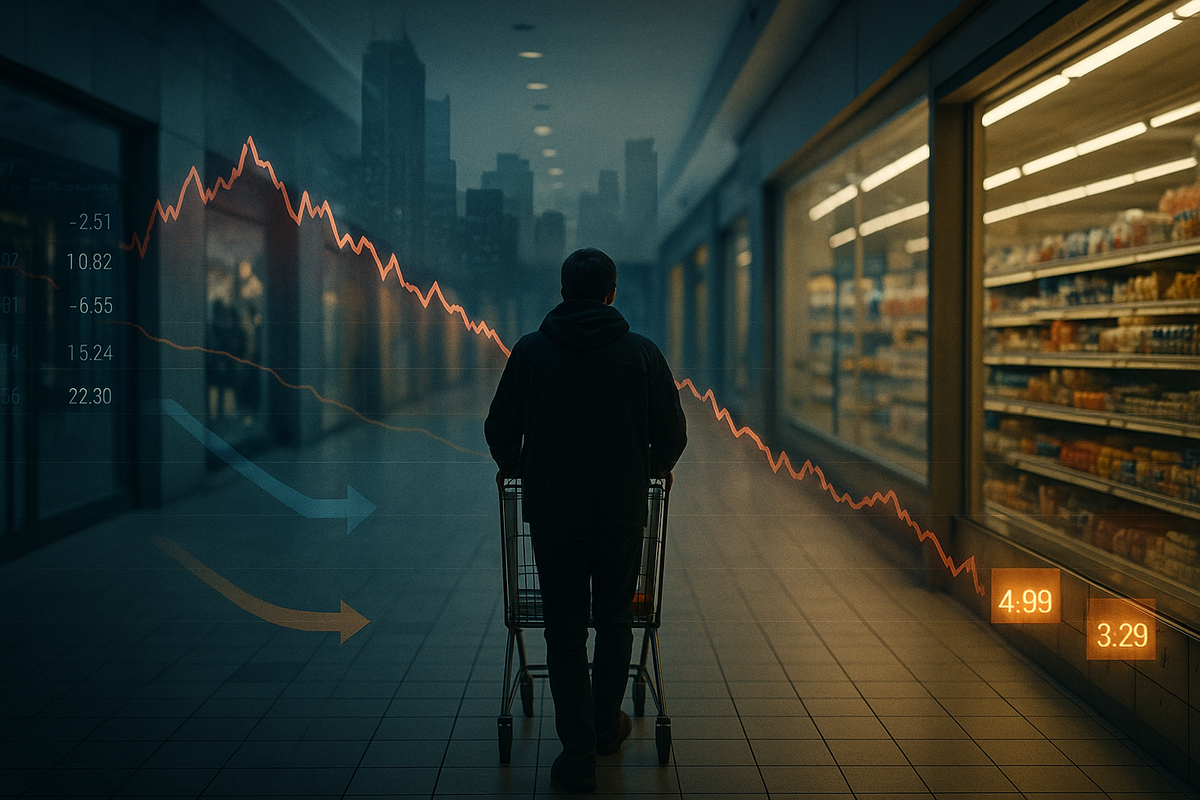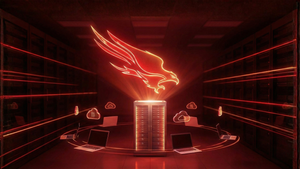Waning Consumer Confidence: A Headwind for Economic Growth and Sectoral Rotation

Consumer confidence, a pivotal barometer of economic health, has shown persistent signs of weakening in recent months, casting a shadow over the global economic outlook. Driven by a cocktail of persistent inflation, rising interest rates, and growing labor market anxieties, this decline signals a potential retrenchment in consumer spending, which accounts for the lion's share of economic activity. The immediate implications are clear: a likely slowdown in economic growth and increased volatility in financial markets, as investors brace for a period of belt-tightening among households. This shift is already prompting a significant sectoral rotation in the stock market, away from growth-oriented discretionary spending and towards the more resilient consumer staples.
This widespread dip in consumer optimism suggests that consumers are increasingly wary about their financial futures, leading them to prioritize essential purchases and defer non-essential expenditures. Businesses reliant on robust consumer demand face an uphill battle, while those providing everyday necessities may find themselves in a comparatively advantageous position. The unfolding scenario could redefine market leadership and investment strategies in the coming months.
A Growing Sense of Unease: What Happened and Why It Matters
The decline in consumer confidence is not an isolated event but a trend that has been building over the past year, reaching concerning levels in several key economies. In September 2025, the GfK Consumer Confidence Index in the UK fell to -19, reflecting an eight-point year-over-year reduction in sentiment regarding the general economic situation. Similarly, the University of Michigan consumer sentiment in the United States dropped to 55.4, its second consecutive monthly decline and the lowest since May. The Conference Board's Consumer Confidence Index, while holding somewhat steadier, saw its Expectations Index—a key predictor of future recession—fall below the critical 80-point threshold in earlier months of 2025, historically signaling an economic contraction within the next year.
Several factors are fueling this pervasive sense of unease. Persistent inflation remains the top concern, with consumers observing higher prices for food, groceries, and energy. This erosion of purchasing power, coupled with historically low savings and high credit card balances, is forcing households to make difficult financial choices. Labor market anxieties, while varying by region, are also contributing, with a decline in perceived job availability and growing pessimism about future job security. Furthermore, fluctuating interest rates, geopolitical uncertainties, and in some regions, expectations of higher taxes, are collectively weighing on consumer sentiment. When consumers feel less secure, they tend to reduce spending, which can lead to shrinking business revenues, potential job losses, and a broader economic slowdown, ultimately increasing the risk of a recession.
Navigating the Shift: Winners and Losers in a Cautious Market
The prevailing climate of waning consumer confidence is poised to trigger a significant reallocation of capital in the stock market, manifesting as a rotation from cyclical consumer discretionary stocks to the more stable consumer staples. This "flight to safety" reflects investors' preference for businesses with predictable demand and resilient earnings during periods of economic uncertainty.
The Vulnerable: Consumer Discretionary Sector Companies in the consumer discretionary sector, which provide non-essential goods and services, are most vulnerable to declining confidence. As consumers tighten their belts, purchases like new cars, luxury items, and vacations are often postponed or canceled. Highly sensitive to economic cycles, this sector is expected to face significant headwinds.
- Automotive: Manufacturers like Tesla (NASDAQ: TSLA) and Ford Motor Company (NYSE: F) may see reduced demand for new vehicles.
- High-End Retail & Luxury Goods: Brands such as NIKE (NYSE: NKE) and other luxury apparel and accessory companies are likely to experience a drop in sales.
- Travel and Leisure: Companies including Marriott International (NASDAQ: MAR), Hyatt Hotels (NYSE: H), Walt Disney Co. (NYSE: DIS), Royal Caribbean Group (NYSE: RCL), and Carnival Corp. (NYSE: CCL) could see reduced bookings and attendance.
- Household Durables: Manufacturers of furniture and appliances like Whirlpool Corp. (NYSE: WHR) or retailers like Williams-Sonoma (NYSE: WSM) may suffer as big-ticket items are delayed.
- Non-Essential Food Services: While often seen as defensive, some fast-food and casual dining chains, such as Starbucks (NASDAQ: SBUX) and Chipotle Mexican Grill (NYSE: CMG), could see reduced traffic as consumers opt to cook more at home. Even Amazon (NASDAQ: AMZN), a dominant force in e-commerce, is classified within consumer discretionary and its growth could be affected by a broader consumer pullback on non-essentials.
The Beneficiaries: Consumer Staples Sector Conversely, the consumer staples sector, comprising companies that produce and sell essential goods, is expected to benefit from this shift. Demand for these products is relatively inelastic, meaning consumers continue to purchase them regardless of economic conditions.
- Food and Beverage: Giants like PepsiCo (NASDAQ: PEP), The Coca-Cola Company (NYSE: KO), Mondelez International (NASDAQ: MDLZ), General Mills (NYSE: GIS), and Kellanova (NYSE: K) are well-positioned as consumers prioritize groceries.
- Household and Personal Care Products: Companies such as Procter & Gamble (NYSE: PG), Colgate-Palmolive (NYSE: CL), and Unilever (NYSE: UL) are likely to see stable demand for everyday necessities.
- Discount and Value Retailers: As price sensitivity increases, retailers offering lower-cost essential goods, such as Walmart (NYSE: WMT) and Costco Wholesale (NASDAQ: COST), could see increased foot traffic and sales.
- Tobacco and Alcohol: Companies like Philip Morris International (NYSE: PM) and Altria Group (NYSE: MO) often exhibit consistent demand due to brand loyalty, even during economic downturns.
This rotation is a classic defensive play, as investors seek stability and reliable dividends in an uncertain economic environment.
Broader Implications and Historical Parallels
The widespread erosion of consumer confidence signals more than just a momentary dip in sentiment; it represents a significant economic indicator with broader industry repercussions and potential policy implications. Historically, a sustained decline in consumer optimism has often preceded or coincided with economic slowdowns and recessions, serving as an early warning for policymakers and businesses alike.
This current trend aligns with broader industry patterns seen during previous periods of economic stress. Retailers, hospitality, and automotive sectors are particularly exposed, facing reduced sales and potential contractions. The ripple effects extend through supply chains, impacting manufacturers and suppliers upstream who face lower orders, inventory gluts, and strained partnerships. Financial institutions may also experience a decrease in loan origination volumes as consumers become less inclined to take on new debt for large purchases. Small-cap companies, often more reliant on debt financing for growth, could find themselves in a precarious position if demand falters. The intensified competition for a smaller pool of consumer dollars could also spur industry consolidation as weaker players struggle to survive.
Governments and central banks are closely monitoring these developments. Historically, a low Consumer Confidence Index (CCI) has often prompted central banks, such as the Federal Reserve, to adjust monetary policy. For instance, in September 2025, the Federal Reserve cut its benchmark federal funds rate by 25 basis points, acknowledging increasing downside risks to growth amidst declining consumer sentiment. Such moves aim to stimulate borrowing and spending, thereby boosting economic growth. Governments may also consider fiscal stimulus measures, like increased spending or tax cuts, to inject money into the economy and restore consumer confidence. Past events, such as the "Great Recession" of 2008-09 and the initial phases of the COVID-19 pandemic, demonstrated how rapidly consumer confidence can collapse and how deeply it can impact economic activity, underscoring the critical role of proactive policy responses. The current situation echoes earlier periods of high inflation and uncertainty, such as the UK's cost-of-living crisis in 2022, when confidence hit record lows.
What Comes Next
The path forward in an environment of waning consumer confidence presents a range of possibilities, demanding strategic pivots from both businesses and consumers. In the short term, the immediate consequences will likely include continued volatility in equity markets and a pronounced shift in consumer spending habits, with essentials dominating budgets.
For businesses, the imperative is clear: adapt or face significant challenges. Strategic pivots will include a heightened focus on value propositions, offering affordable quality in products and services to appeal to increasingly budget-conscious consumers. Aggressive pricing strategies and incentives, particularly for big-ticket items like homes and cars, may become commonplace to stimulate demand. Building trust and transparency will also be crucial, as consumers are likely to be more discerning and skeptical. Companies that can demonstrate empathy, ethical leadership, and consistent reliability—eliminating hidden fees, simplifying return policies, and being upfront about price changes—will likely fare better. Supply chain agility will also be paramount to navigate potential disruptions and cost pressures.
For consumers, the adaptation will involve a continued prioritization of needs over wants, increased scrutiny of purchases, and a delay in large investments. There's a potential for a continued trend toward financial prudence, with lower savings and higher credit card balances prompting ongoing spending cutbacks.
Looking ahead, several scenarios could unfold. A recessionary scenario is plausible if confidence indices remain consistently low, leading to widespread job losses and a sustained reduction in spending. Conversely, a soft landing scenario could emerge if central bank rate cuts effectively stimulate the economy without triggering a full-blown recession, potentially leading to moderate, sustainable growth. A modest growth scenario is also possible, where businesses remain hesitant despite cheaper capital, or the benefits of rate cuts are partially offset by persistent inflation. Regardless, market opportunities will arise in defensive sectors and for brands that excel in delivering value and building trust. However, challenges such as sustained inflationary pressures and potential labor market deterioration will persist, requiring vigilance and adaptability.
Conclusion
The current landscape of waning consumer confidence is a critical development for the global economy and financial markets. Driven by persistent inflation, economic uncertainties, and shifting labor market dynamics, this decline portends a period of reduced consumer spending and heightened market volatility. The resulting sectoral rotation from cyclical consumer discretionary stocks to more stable consumer staples underscores a broader investor preference for resilience and predictable earnings in uncertain times.
Key takeaways from this event emphasize the interconnectedness of consumer sentiment with broader economic health and market performance. Companies providing non-essential goods face an uphill battle, while those focused on everyday necessities are poised for relative stability. The implications are far-reaching, from potential ripple effects across supply chains to prompting monetary and fiscal policy responses aimed at stabilizing the economy.
Moving forward, investors should closely monitor consumer confidence indices, inflation data, and central bank policy decisions. Businesses must prioritize value, transparency, and agility in their operations and marketing strategies to navigate a more cautious consumer environment. The lasting impact of this period of diminished confidence will likely reshape consumer behaviors, reinforce the importance of financial prudence, and reward companies that can effectively adapt to a new economic reality. The coming months will be crucial in determining whether economies can achieve a soft landing or if further headwinds will lead to a more significant downturn.
More News
View More




Recent Quotes
View More
Quotes delayed at least 20 minutes.
By accessing this page, you agree to the Privacy Policy and Terms Of Service.